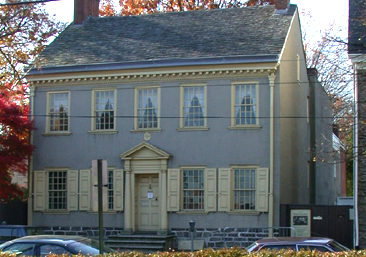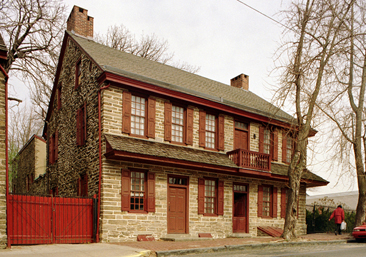Germantown Philadelphia, PA USA |
Enhancing the Experience
A consortium of organizations with holdings within Historic Germantown devised a project to test the feasibility of adapting a traditional and highly successful collaborative tour for school groups to the new potential of interactive graphics technologies. The then current tour utilized buses, site visits, and person-to-person interpretation at three historic Germantown houses and the exhibits at the Historical Society. Through the use of interactive computer technologies, the consortium felt that the basic concepts of what constitutes historic site visits could be effectively challenged. Since no similar efforts could be found at other historic sites, the scope of the project and the technologies to be adopted were carefully defined by the consortium.Germans, Generals, and Gentlemen
The project was brought to Learning Sites, Inc. (a strategic partner of the Institute for the Visualization of History) in 2001 to help improve the interpretive message, enrich the educational programs, and expand the public service of the collaborating organizations. Three historic houses, the Deshler-Morris House, Grumblethorpe, and Cliveden, were chosen as the focus of the project, under the title Germans, Generals, and Gentlemen, an already successful school tour theme.
click on the image to enlargeThe Deshler-Morris House was originally constructed by merchant David Deshler c.1773. It was included in the project because it became Sir William Howe’s headquarters during the Battle of Germantown, and subsequently, President George Washington’s residence during the yellow fever outbreak in Philadelphia during the summers of 1790 and 1794. The house is currently run and operated by the National Park Service’s Independence National Historic Park.
click on the image to enlargeGrumblethorpe was built in 1744 by wine importer John Wister as a summer retreat. It is typical of Pennsylvania German architecture, with a facade of coursed stone, pent eaves, double front entry, and front and rear balconies. The rear gardens of the house are equally important, as they hold a ginko tree that dates to the late 1700s, and planting beds that demonstrate the botanical interests of the Wister family. The house is currently run by the Philadelphia Society for the Preservation of Landmarks.
Cliveden, a National Trust for Historic Preservation property, was built between 1763 and 1767 by Benjamin Chew, a jurist. This house was a focus of the Battle of Germantown. The house museum now contains a large collection of decorative arts and documentary material on 175 years of the family’s life. The house is currently run and operated by the National Park Service’s Independence National Historic Park.
Interactive Education
The scope of the foray into new media was to include still photographs, panoramic photographs, text, and audio, all integrated into a package that could be run online, locally at each historic house, or off of a CD-ROM at home or in the classroom.Reference
Page Created: October 5, 2004
Page Updated: October 7, 2009
URL:
Page Author: The Institute for the Visualization of History

